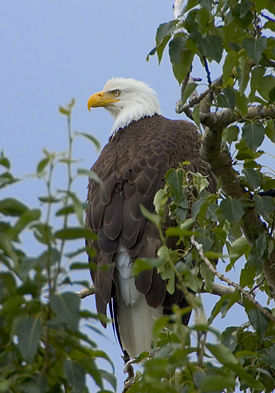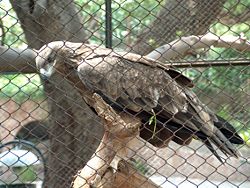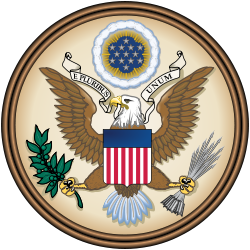Eagle
| Eagle | ||||||||||
|---|---|---|---|---|---|---|---|---|---|---|
 |
||||||||||
| Scientific classification | ||||||||||
|
||||||||||
| Genera | ||||||||||
|
Several, see text. |
Eagles are large birds of prey which are members of the bird order Accipitriformes and family Accipitridae, and belong to several genera which are not necessarily closely related to each other genetically. Most of the more than 60 species occur in Eurasia and Africa.[1] Outside this area, just two species (the Bald and Golden Eagles) can be found in the USA and Canada, nine more in Central and South America, and three in Australia.
Contents |
Description
Eagles are differentiated from other birds of prey mainly by their larger size, more powerful build, and heavier head and bill. Even the smallest eagles, like the Booted Eagle (which is comparable in size to a Common Buzzard or Red-tailed Hawk), have relatively longer and more evenly broad wings, and more direct, faster flight. Most eagles are larger than any other raptors apart from the vultures.
Like all birds of prey, eagles have very large powerful hooked beaks for tearing flesh from their prey, strong legs, and powerful talons. They also have extremely keen eyesight which enables them to spot potential prey from a very long distance.[2] This keen eyesight is primarily contributed by their extremely large pupils which cause minimal diffraction (scattering) of the incoming light.
Eagles build their nests, called eyries, in tall trees or on high cliffs. Many species lay two eggs, but the older, larger chick frequently kills its younger sibling once it has hatched.
Species

Major new research into eagle taxonomy suggests that the important genera Aquila and Hieraaetus are not composed of nearest relatives, and it is likely that a reclassification of these genera will soon take place, with some species being moved to Lophaetus or Ictinaetus.[3]
- Bonelli's Eagle, the Booted Eagle and the Little Eagle have been moved from Hieraaetus to Aquila.
- Either the Greater Spotted Eagle and Lesser Spotted Eagle should move from Aquila to join the Long-crested Eagle in Lophaetus, or, perhaps better, all three of these species should move to Ictinaetus with the Black Eagle.
- The Steppe Eagle and Tawny Eagle, once thought to be conspecific, are not even each other's nearest relatives.
FAMILY ACCIPITRIDAE
- Subfamily Buteoninae - hawks (buzzards), true eagles and sea-eagles
- Genus Geranoaetus
- Black-chested Buzzard-eagle, Geranoaetus melanoleucus
- Genus Harpyhaliaetus
- Crowned Solitary Eagle, Harpyhaliaetus coronatus
- Solitary Eagle, H. solitarius
- Genus Morphnus
- Crested Eagle, Morphnus guianensis
- Genus Geranoaetus
-
- Genus Harpia
- Harpy Eagle, Harpia harpyja
- Genus Pithecophaga
- Philippine Eagle, Pithecophaga jefferyi
- Genus Harpyopsis
- New Guinea Eagle, Harpyopsis novaeguineae
- Genus Oroaetus
- Black-and-chestnut Eagle, Oroaetus isidori
- Genus Spizaetus
- Cassin's Hawk-eagle, Spizaetus africanus
- Changeable Hawk-eagle, S. cirrhatus
- Mountain Hawk-eagle, S. nipalensis
- Blyth's Hawk-eagle, S. alboniger
- Javan Hawk-eagle, S. bartelsi
- Sulawesi Hawk-eagle, S. lanceolatus
- Philippine Hawk-eagle, S. philippensis
- Wallace's Hawk-eagle, S. nanus
- Black Hawk-eagle, S. tyrannus
- Ornate Hawk-eagle, S. ornatus
- Black-and-white Hawk-eagle, S. melanoleucus
- Genus Lophaetus
- Long-crested Eagle, Lophaetus occipitalis - possibly belongs in Ictinaetus
- Genus Stephanoaetus
- Crowned Hawk-eagle, Stephanoaetus coronatus
- Genus Polemaetus
- Martial Eagle, Polemaetus bellicosus
- Genus Hieraaetus
- Ayres' Hawk-eagle, Hieraaetus ayresii
- African Hawk Eagle, H. spilogaster
- New Guinea Hawk-eagle, H. weiskei
- Genus Harpia

-
- Genus Harpagornis (extinct)
- Haast's Eagle, Harpagornis moorei - possibly belongs in either Hieraaetus or Aquila[4]
- Genus Aquila
- Bonelli's Eagle, Aquila fasciata - formerly Hieraaetus fasciatus
- Booted Eagle, A. pennata - formerly Hieraaetus pennatus
- Little Eagle, A. morphnoides
- Golden Eagle, A. chrysaetos
- Eastern Imperial Eagle, A. heliaca
- Rufous-bellied Eagle, A. kienerii
- Spanish Imperial Eagle A. adalberti
- Steppe Eagle, A. nipalensis
- Tawny Eagle, A. rapax
- Greater Spotted Eagle, A. clanga - to be moved to Lophaetus or Ictinaetus
- Lesser Spotted Eagle, A. pomarina - to be moved to Lophaetus or Ictinaetus
- Indian Spotted Eagle, A. hastata - to be moved to Lophaetus or Ictinaetus
- Verreaux's Eagle, A. verreauxii
- Gurney's Eagle, A. gurneyi
- Wahlberg's Eagle, A. wahlbergi
- Wedge-tailed Eagle, A. audax
- Genus Ictinaetus
- Black Eagle, Ictinaetus malayensis
- Genus Haliaeetus
- White-tailed Eagle, Haliaeetus albicilla
- Bald Eagle, H. leucocephalus
- Steller's Sea-eagle, H. pelagicus
- African Fish-eagle, H. vocifer
- White-bellied Sea-eagle, H. leucogaster
- Sanford's Fish-eagle, H. sanfordi
- Madagascar Fish-eagle, H. vociferoides
- Pallas' Sea-eagle, H. leucoryphus
- Genus Ichthyophaga
- Lesser Fish-eagle, Ichthyophaga humilis
- Grey-headed Fish-eagle, I. ichthyaetus
- Genus Harpagornis (extinct)
- Subfamily Circaetinae: snake-eagles
- Genus Terathopius
- Bateleur, Terathopius ecaudatus
- Genus Circaetus
- Short-toed Eagle, Circaetus gallicus
- Black-chested Snake-eagle, C. pectoralis
- Brown Snake-eagle, C. cinereus
- Fasciated Snake-eagle, C. fasciolatus
- Banded Snake-eagle, C. cinerascens
- Genus Spilornis
- Crested Serpent-eagle, Spilornis cheela
- Nicobar Serpent-eagle, S. minimus
- Mountain Serpent-eagle,S. kinabaluensis
- Sulawesi Serpent-eagle, S. rufipectus
- Philippine Serpent-eagle, S. holospilus
- Andaman Serpent-eagle, S. elgini
- Genus Eutriorchis
- Madagascar Serpent-eagle, Eutriorchis astur
- Genus Terathopius
Eagles in culture
The word
The modern English name of the bird is derived from the Latin term aquila by way of the French Aigle. The Latin aquila may derive from the word aquilus, meaning dark-colored, swarthy, or blackish, as a description of the eagle's plumage; or from Aquilo, the Latin version of Greek Boreas, or north wind.
Old English used the term Earn, related to Scandinavia's Ørn / Örn. The etymology of this word is related to Greek ornis, literally meaning "bird". In this sense, the Eagle is the Bird with a capital B.
In Britain before 1678, Eagle referred specifically to the Golden Eagle, the other native species, the White-tailed Eagle, being known as the Erne. The modern name "Golden Eagle" for Aquila chrysaetos was introduced by the naturalist John Ray.
Eagles as national symbols




Eagles have been used by many nations as a national symbol.
- The coat of arms of Albania has a black double-headed eagle.
- The coat of arms of Armenia has a gold eagle and lion.
- The coat of arms of Austria has a black eagle.
- The coat of arms of the Czech Republic integrates the symbols of Moravia and Silesia (both with female eagles in their emblems - red-and-white chequered and black respectively) on the coat of arms of the Czech Republic with Bohemia's lion.
- The coat of arms of Egypt is a golden eagle looking towards the viewer's left.
- The coat of arms of Germany has a black eagle.
- The coat of arms of Ghana has two golden eagles holding it.
- The coat of arms of Iceland has a eagle holding it, as well as a dragon, a bull and a giant.
- The coat of arms of Indonesia has an eagle-like garuda carrying a shield on its neck and a banner on its feet.
- The coat of arms of Iraq has the golden Eagle of Saladin
- The coat of arms of Jordan has a black eagle.
- The coat of arms of Mexico golden eagle perched upon a cactus devouring a snake.
- The coat of arms of Moldova consists of a stylized eagle holding a cross in its beak and a sceptre and a branch in its claws.
- The coat of arms of Montenegro represents the two-headed eagle in flight.
- The coat of arms of Navarre/Basque Country Kingdom has a black eagle.
- The coat of arms of Nigeria has a red eagle on top.
- The Insignia of the Pakistan Air Force includes the Peregrine Falcon State Military national bird.
- The coat of arms of Panama has a harpy eagle
- The coat of arms of the Philippines has the bald eagle of the United States, but the Monkey-eating Eagle is the de jure National Bird of the country.
- The coat of arms of Poland has a white eagle with a golden beak and talons wearing a golden crown.
- The coat of arms of Romania has a golden aquila holding a cross in its beak and a mace and a sword in its claws.
- The coat of arms of Russia has a double-headed eagle.
- The coat of arms of Serbia has a white bicephalic eagle of the House of Nemanjić.
- The coat of arms of Syria formerly had the eagle of Saladin.
- The Great Seal of the United States has a bald eagle.
- The coat of arms of Yemen depicts a golden eagle with a scroll between its claws.
- The coat of arms of Zambia has a orange red eagle on top.
Historic uses:
- The Ptolemaic rulers of Egypt used it as their seal.
- Napoleon Bonaparte used the Roman Golden Eagle as the symbol of his new French empire.
- Persian Empire: the symbol of Persian Army was an Eagle
- The Romans used it on the standards of their armies. From this derives:
- The late Byzantine Empire chose a two-headed golden eagle as its symbol. It is popularly that one head symbolised ancient Rome, and the other head symbolised "new Rome" at Constantinople. From this derives:
- The two-headed eagle is the emblem of "Shqipëria" or Land of the Eagles, which is known in English as Albania (see The Tale of the Eagle for the legendary origin of the name)
- After the fall of Constantinople, the Russian Empire took the two-headed eagle as its own symbol.
- After his crowning as the new Roman Emperor, Charlemagne adopted the ancient Roman eagle as his own symbol. The Holy Roman Empire born of his kingdom took the eagle, but the Habsburgs replaced the golden eagle by an imperial eagle. From this derives:
- The Austrian Empire had a two-headed eagle as its symbol. After the abolition of Austria-Hungary, Austria took as its symbol a one-headed eagle in the modern coat of arms of Austria.
- Prussia, and later Germany have used a black eagle as their national symbol.
- The Spanish Catholic monarchs, Isabella and Ferdinand, used the eagle as a part of the royal shield representing Saint John the Evangelist. The eagle was again on the Spanish shield under the Francoist regime and the transition to Democracy (1939-1981).
- The late Byzantine Empire chose a two-headed golden eagle as its symbol. It is popularly that one head symbolised ancient Rome, and the other head symbolised "new Rome" at Constantinople. From this derives:
- The Seljuk Turks and Ottoman Turks used a double-headed eagle as coats-of-arms.
The eagle is the symbol used to depict John the Apostle in some Christian churches, whose writing most clearly witnesses the divinity of Christ. In art, John, as the writer of the Gospel, is sometimes depicted with an eagle. See Names of John.
The eagle is a sacred bird in some cultures and the feathers of the eagle are central to many religious and spiritual customs, especially amongst Native Americans in the United States and First Nations in Canada, as well as among many of the peoples of Meso-America. Some Native American peoples revere eagles as sacred religious objects and the feathers and parts of Bald and Golden Eagles are often compared to the Bible and crucifix. Eagle feathers are often used in various ceremonies and are used to honor noteworthy achievements and qualities such as exceptional leadership and bravery. In the cultures of the Northwest Coast, Eagle is also a supernatural being and also the ancestor and features in the heraldic crests of important clans known as totem poles.
The Moche people of ancient Peru worshipped the animal and often depicted eagles in their art.[5]
Despite modern and historic Native American practices of giving eagle feathers to non-indigenous people and also members of other tribes who have been deemed worthy, current United States eagle feather law stipulates that only individuals of certifiable Native American ancestry enrolled in a federally recognized tribe are legally authorized to obtain eagle feathers for religious or spiritual[6] In Canada, poaching of eagle feathers for the booming U.S. market has sometimes resulted in the arrests of First Nations person for the crime.[7]
Eagles as organizational symbols

- Black Eagles is used for the Turkish sports club Beşiktaş J.K..Turkish Seljukian double headed eagle emblem.
- The image of a Golden Eagle is displayed the coat of arms of one of Scotland's most powerful clans, Munro. Gaelic Rothach.
- The double-headed eagle is the emblem of the Greek sport clubs AEK (black eagle with open wings on yellow background) and PAOK (black eagle with closed wings on white background, as a symbol of mourning). It is a symbol of the clubs' origins, since both clubs were founded by Greeks who fled to Greece from Constantinople in 1922-23. The eagle itself is derived from the later version of the Roman Eagle, the Byzantine- or East Roman eagle.
- The Roman eagle is the symbol of the Roman sports club S.S. Lazio.
- The Nigeria Football Association, the nation's football (soccer) governing body, has a green eagle perched on a football as its organisational symbol and logo. The Nigerian national football team is known as the 'Super Eagles', the under-20 youth team as the 'Flying Eagles', and the under-17 national side as the 'Golden Eaglets'. They all have an eagle as their symbol.
- Eagle is the symbol of the Portuguese football team Sport Lisboa e Benfica.
- Eagle is the mascot from Mexico's Club America´s football club, since 1981.
- The Philadelphia franchise of the National Football League is known as the Eagles
- The Puerto Rico Statehood Students Association has an eagle in its seal.
- The Eagle Scout rank is the highest award in the Boy Scouts of America.
References
- ↑ del Hoyo, J.; Elliot, A. & Sargatal, J. (editors). (1994). Handbook of the Birds of the World Volume 2: New World Vultures to Guineafowl. Lynx Edicions. ISBN 8487334156
- ↑ Shlaer, Robert (1972-05-26). "An Eagle's Eye: Quality of the Retinal Image". Science 176 (4037): 920–922. doi:. PMID 5033635. http://www.sciencemag.org/cgi/content/abstract/176/4037/920?ck=nck. Retrieved on 2007-11-20.
- ↑ Lerner, H. R. L.; D. P. Mindell (2005). "Phylogeny of eagles, Old World vultures, and other Accipitridae based on nuclear and mitochondrial DNA". Molecular Phylogenetics and Evolution 37 (37): 327–346. doi:.
- ↑ Bunce, M.; et al (2005). "Ancient DNA Provides New Insights into the Evolutionary History of New Zealand's Extinct Giant Eagle". PLoS Biol 3 (1): e9. doi:. http://biology.plosjournals.org/perlserv/?request=get-document&doi=10.1371%2Fjournal.pbio.0030009. Retrieved on 2006-12-27.
- ↑ Berrin, Katherine & Larco Museum. The Spirit of Ancient Peru:Treasures from the Museo Arqueológico Rafael Larco Herrera. New York: Thames and Hudson, 1997.
- ↑ Office of Law Enforcement. "National Eagle Repository". Mountain-Prairie Region. United States Fish and Wildlife Service. Retrieved on 2007-11-20.
- ↑ Sin, Lena (2006-04-30). "Charges laid in eagle-poaching case", The Province, CanWest MediaWorks Publications Inc.. Retrieved on 2007-11-20.
- Splitting headaches? Recent taxonomic changes affecting the British and Western Palaearctic lists - Martin Collinson, British Birds vol 99 (June 2006), 306-323
- Bruguier, Leonard.A Warrior's Eagle Feather
See also
- Eagle (heraldry)